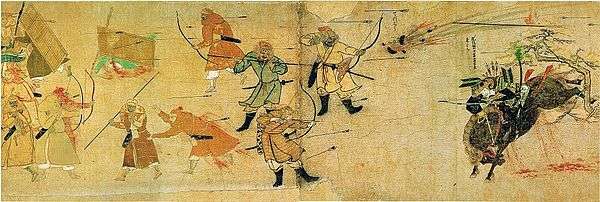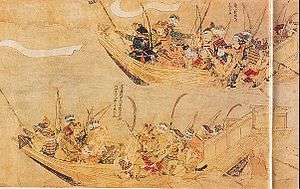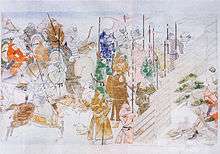Mōko Shūrai Ekotoba
Mōko Shūrai Ekotoba (蒙古襲来絵詞, Illustrated Account of the Mongol Invasion) is a set of two Japanese illustrated handscrolls (emakimono) composed between 1275 and 1293. They were commissioned by the samurai Takezaki Suenaga in order to record his battlefield valor and deeds during the Mongol invasions of Japan.

The author and artist are unknown. The scrolls show images of battles between the Mongol invaders and Japanese defenders on land and on the seas. Pictures are occasionally truncated by accompanying text. Several versions of the scrolls exist: the original 13th-century version, an 18th-century copy, a hand-drawn copy by Fukuda Taika dating from the 19th century, and a 21st-century reconstruction. The original is currently stored at the Museum of the Imperial Collections in Tokyo Imperial Palace.
Images


 Japanese attack ships
Japanese attack ships Mongol soldiers, second version
Mongol soldiers, second version Mongol ships, second version
Mongol ships, second version
See also
- Takezaki Suenaga
- Battle of Bun'ei
- Battle of Kōan
- Mongol Invasions of Japan
External links
| Wikimedia Commons has media related to Mōko Shūrai Ekotoba. |
- Scrolls of the Mongol Invasions of Japan - Full digitized scans of the scrolls, all versions, including commentary and translations, Bowdoin College Museum of Art
- Mōko Shūrai Ekotoba (蒙古襲来絵詞) - High resolution scans of the 18th century copy, digital archives of Kyushu University
Bibliography
- Okudaira, Hideo (1973). Narrative picture scrolls. Arts of Japan. 5. Weatherhill. ISBN 978-0-8348-2710-3.
- Conlan, Thomas (2001). In little need of divine intervention: Takezaki Suenaga's scrolls of the Mongol invasions of Japan. Cornell East Asia series. 113. Cornell University. ISBN 978-1-885445-13-1.
- Tanaka, Ichimatsu (1964). Heiji monogatari emaki, Mōko shūrai ekotoba. Nihon emakimono zenshū (in Japanese). 9. Kadokawa Shoten.
- Komatsu, Shigemi (1978). 蒙古襲来絵詞 (Mōko shūrai ekotoba). Nihon emaki taisei (in Japanese). 14. Chuokoron-Shinsha.
